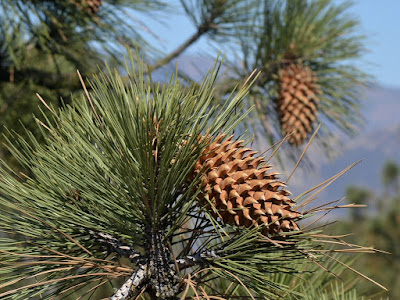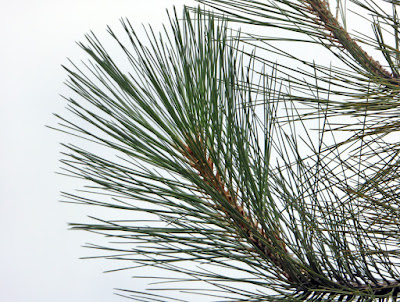Pinus coulteri is native to the coastal mountains of Southern California and northern Baja California (Mexico). It grows in dry rocky slopes, flats, ridges, and chaparral, transitional to oak-pine woodland at elevations of 300-2100 meters above sea level. It is hardy to USDA Hardiness Zone 8 to 10.
Pinus coulteri also called as Coulter pine, Big-cone pine, is a species of the genus Pinus. This species was described by David Don in 1837. The species is named after Thomas Coulter, an Irish botanist and physician.
IDENTIFY PINUS COULTERI -COULTER PINE PLANTS
Pinus coulteri is native to the coastal mountains of Southern California and northern Baja California (Mexico). It grows in dry rocky slopes, flats, ridges, and chaparral, transitional to oak-pine woodland at elevations of 300-2100 meters above sea level. It is hardy to USDA Hardiness Zone 8 to 10.
Coulter pine is a substantial coniferous evergreen tree which reaching up to 24m tall and to 1m in diameter with broad, thin, irregular crown that has dark gray-brown to near black, deeply furrowed bark, violet-brown twigs (aging gray-brown), deep red-brown buds. The leaves are 3 per fascicle, slightly spreading, not drooping, mostly ascending in a brush, slightly curved or straight, twisted, dusty gray-green. Pollen cones ovoid to cylindric, light purple-brown, aging orange-brown. Seed cones maturing in 2 years, narrowly ovoid before opening, ovoid-cylindric when open, pale yellow-brown, resinous. Seeds obovoid, dark brown.
Big-cone pine has no particular commercial value as a timber tree and its seeds, although edible, are not harvested for consumption. It is quite frequently represented in parks and arboreta in southern Europe and the milder parts of the British Isles, and this pine has also been introduced as an amenity tree in Australia and New Zealand. In California it is also planted in parks and large gardens, often in small groups. The impressive cones are often collected and displayed as curiosities in private houses as well as schools and other public buildings.
PINUS COULTERI -COULTER PINE PLANTS CARE AND CULTIVATION
The cultivation of these plants presents no special difficulties, if proper soil and exposure are available. The question of hardiness is, of course, all-important. It is not only the problem of temperature the given tree will stand, but also the exposure to winds, and, to a considerable extent, the source from which the tree is derived. If the plants are raised from seeds matured in similar or even more rigorous climates, they are usually more hardy.
Soils:
Pinus coulteri prefer a well-drained porous gravelly subsoil, overlaid with a light sandy loam. They seem to be particularly happy in a soil underlaid with a porous glacial drift. In cultivation, however, they succeed very well in ordinary well-drained soil. When the plants are set in clay soil, which is often done, the soil should be thoroughly loosened by trenching or subsoil plowing, and well underdrained. Any available humus, woodashes, and well-rotted manure incorporated in the soil greatly aid in rendering it friable and porous for the roots.
Manures and mulches:
Mulching with ordinary well-rotted barnyard manure in late autumn affords much stimulus to growth. By the following spring the manure will be in a desiccated condition and can be incorporated with the soil. A heavy mulch of old straw, rotten hay, or any similar material over the roots, and this was maintained throughout the entire growing season is benefit to the plants in a more or less juvenile condition.
In many cases manure is not obtainable. In such event, newly moved plants should be heavily mulched with rotten straw, rotten hay, or any similar rubbish for a few years until they become established. The frequent stirring of the ground over the roots subsequently will conserve sufficient moisture.
An area extending from the stem to one to two feet beyond the branches, stirred up with hoe and rake perhaps five or six times throughout the growing season, is very beneficial in conserving the moisture around the roots.
Pruning:
Removal of the lower branches of Coulter Pine is a serious mistake, and, if healthy, they should be retained to the base. Pruning or disbudding can be intelligently performed to add much to the natural symmetry. The extraction or removal, early in spring, of the central or terminal bud, will tend to compel the branches which start from the side buds to spread apart and form a much denser growth. Cutting back the previous year's terminal growth to a strong bud or branchlet on the main limbs over the tree, if the plant is inclined to be thin in its branching, always produces a much denser lateral growth.
Transplanting:
Transplanting can be done at all times of the year, excepting midsummer when they are in full growth. The best success is secured in spring when the buds begin to swell. From the end of August to the middle of September, if there have been abundant rains and the ground has been well soaked, is a very good time to move the plants. They may be planted late in autumn when circumstances compel it, but there is likely to be a considerable percentage of loss. Their roots are very susceptible to injury from exposure to the air, and the utmost vigilance should be exercised to keep them covered and moist.

















COMMENTS